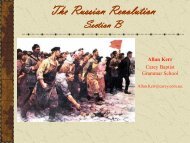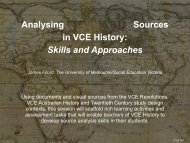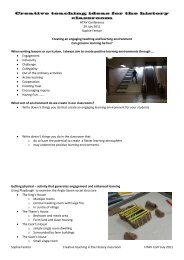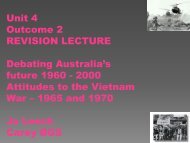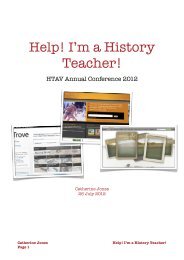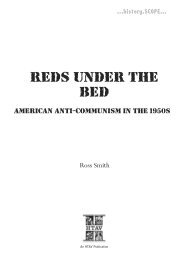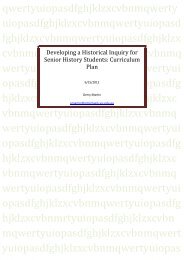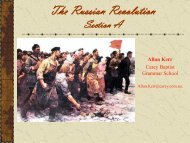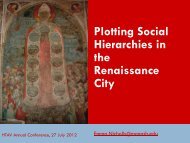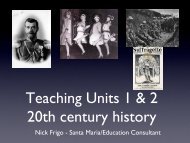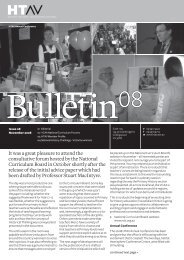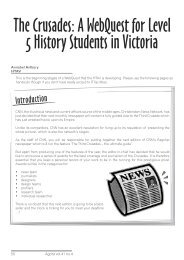Social Life in Renaissance Florence - HTAV
Social Life in Renaissance Florence - HTAV
Social Life in Renaissance Florence - HTAV
Create successful ePaper yourself
Turn your PDF publications into a flip-book with our unique Google optimized e-Paper software.
Suzanne Bell<br />
St. Cather<strong>in</strong>e’s School
The social structure<br />
Popolo grasso- patricians<br />
Power, wealth and status<br />
Members of major guilds<br />
10% of population<br />
Popolo m<strong>in</strong>uto- lower classes<br />
Wide disparity <strong>in</strong> wealth- m<strong>in</strong>or guildsmen to vagabonds<br />
90% of the population
The urban landscape<br />
Mean<strong>in</strong>g of the term ‘social map’<br />
Importance of neighbourhood<br />
Streets and piazze as public and private space<br />
Civic centre- Piazza della Signoria<br />
Religious centre- Cathedral and Baptistry
Nature of Florent<strong>in</strong>e society<br />
The precarious world of <strong>Renaissance</strong> <strong>Florence</strong>- Agnolo<br />
Acciaiuoli “a paradise <strong>in</strong>habited by devils.”<br />
- Ronald Weissman- ‘agonistic’<br />
The importance of belong<strong>in</strong>g to corporate groups, such as<br />
guilds, confraternities, families, neighbourhoods <strong>in</strong><br />
medieval times. Did this cont<strong>in</strong>ue?
Historiography<br />
Jacob Burkhardt- <strong>Renaissance</strong> Italy “began to swarm with<br />
<strong>in</strong>dividuality” as its men and women were freed from the<br />
“countless bonds” of medieval solidarities and corporations,<br />
such as clan, guilds and neighbourhoods.<br />
Gene Brucker- “By the end of the 14 th century, these corporate<br />
groups were decl<strong>in</strong><strong>in</strong>g <strong>in</strong> strength and vitality, and were<br />
play<strong>in</strong>g a less important role <strong>in</strong> Florent<strong>in</strong>e life.<br />
F.W. Kent- “Quattrocento Florent<strong>in</strong>es, however… sought<br />
advantage, protection and comfort <strong>in</strong> a bewilder<strong>in</strong>g variety of<br />
groups and social bonds…which they <strong>in</strong>herited from the late<br />
medieval commune.”
Gonfalone- social life<br />
Historically the gonfalone brigade defended their part of the city wall<br />
Self sufficient neighbourhoods<br />
Families congregated <strong>in</strong> neighbourhoods<br />
- commissioned art and architecture with<strong>in</strong> their own gonfalone<br />
- Family chapels <strong>in</strong> gonfalone<br />
-Families buried together <strong>in</strong> gonfalone<br />
-Marriage- change over time<br />
-Godparent<strong>in</strong>g<br />
-Filippo Strozzi returned after generation of exile to ancestral<br />
gonfalone<br />
Sense of belong<strong>in</strong>g. Weissman “<strong>Social</strong> and psychic support” Kent-<br />
‘Sacred spaces’.<br />
Marched together <strong>in</strong> civic ritual “St. John the Baptist Day”
Importance of Gonfalone- political<br />
advantages<br />
The Scrut<strong>in</strong>y system<br />
Importance of gonfalone recognised <strong>in</strong> the Constitution-<br />
16 Gonfaloniere; Gonfaloniere of Justice (rotation)<br />
BUT<br />
Giovanni Rucellai case study- supports Brucker’s view.
Importance of Gonfalone- economic<br />
advantages<br />
Taxation system, particularly the Estimo.(survived until 1458-<br />
Catasto from 1427-1434)<br />
Giovanni Rucellai, suspect by the regime due to Strozzi l<strong>in</strong>k,<br />
wrote <strong>in</strong> 1457 that he had survived “ because I have been <strong>in</strong> the<br />
grace and benevolence of paternal k<strong>in</strong>smen, relatives,<br />
neighbours and the rest of the men of my gonfalone, who are<br />
much to be praised because always <strong>in</strong> the tax concessions that<br />
are granted locally they have served and helped and had<br />
compassion for me.<br />
Families owned property <strong>in</strong> common often with<strong>in</strong> their own<br />
gonfalone.<br />
A Florent<strong>in</strong>e law stated that if a property was to be sold the<br />
neighbour had the first right of refusal<br />
Economic decisions were made by the family as a unit rather<br />
than by <strong>in</strong>dividuals with<strong>in</strong> a family.
Importance of Family<br />
Political significance<br />
- Congregation of families <strong>in</strong> a particular gonfalone<br />
- A practice ma<strong>in</strong>ta<strong>in</strong>ed throughout the 14 th and 15 th centuries- Catasto<br />
records<br />
- Families acted as a political unit- sworn pacts, laws to regulate power <strong>in</strong><br />
communal governments<br />
Economic significance<br />
- bus<strong>in</strong>ess decisions made collectively<br />
- ownership of property together<br />
Marriage ties<br />
Dowries
Importance of friendship ties<br />
Political and economic network<strong>in</strong>g advantages<br />
Paolo da Certaldo “ a man who loses his friends is worse than<br />
dead.”<br />
Alberti “ Fortunate and affluent men are <strong>in</strong>deed extremely<br />
useful friends, not so much because they will help you with<br />
their wealth and power directly, but because… they can show<br />
you the way to acqua<strong>in</strong>tance with all lesser and ord<strong>in</strong>ary<br />
persons.”<br />
Could be cross class- eg Bartolomeo Cederni and the<br />
Pandolf<strong>in</strong>i family<br />
Brucker argument
Civic ritual<br />
Spiritual/cultural mean<strong>in</strong>g- reciprocal relationship with the<br />
patron sa<strong>in</strong>t- homage from the Florent<strong>in</strong>es <strong>in</strong> return for<br />
protection.<br />
Refusal to allow Savonarola to ban “the devil’s work”<br />
Gave men a sense of belong<strong>in</strong>g to <strong>Florence</strong>.<br />
Gave the government an opportunity to promote the<br />
values of the Republic. (eg St.Anne’s Day and<br />
republicanism. Walter di Brienne exiled on St.Anne’s Day<br />
<strong>in</strong> 1343)<br />
Promotion of civic pride- St. Victor and St. Barnabas<br />
Days.
Confraternities<br />
Spiritual purpose- laudesi and penetential. Importance of salvation<br />
Socio economic- charity eg St Agnese and La Brucciata <strong>in</strong> Green<br />
Dragon; Misericordia<br />
Sense of belong<strong>in</strong>g to city wide group<br />
Possible political network<strong>in</strong>g forum<br />
- dissolution of the Confraternities 1419<br />
- Lorenzo de’ Medici membership of 5 confraternities
Incorporation or exclusion of<br />
marg<strong>in</strong>alised groups- the poor<br />
the differences <strong>in</strong> wealth, hous<strong>in</strong>g and lifestyle between the<br />
patriciate class, who had wealth and power, and the Popolo<br />
M<strong>in</strong>uto, who constituted 90% of the population.<br />
Attitudes- Brucker “a mixture of distaste, compassion and<br />
fear.”<br />
Ritual- excluded from civic ritual but local street festivals<br />
Institutionalised charity<br />
Kent – vertical ties. “to be rather loved than feared”<br />
Confraternities- usually city wide<br />
<strong>Social</strong> map. Weissman- “social bonds (<strong>in</strong> the gonfalone) were<br />
not only dense, but multi faceted.”
Incorporation or exclusion of<br />
marg<strong>in</strong>alised groups- women<br />
Laws- political and economic<br />
Marriage conventions-<br />
- Dowry- legally the widow’s on the death of the husband<br />
but <strong>in</strong> practice difficult to reclaim<br />
- Tornata- right of return to own family<br />
- If widowed they could leave with their dowries but without<br />
their children.<br />
Non <strong>in</strong>clusion <strong>in</strong> ritual- passive onlookers<br />
Restricted <strong>in</strong> physical environment of the city<br />
- law aga<strong>in</strong>st enter<strong>in</strong>g the Palazzo della Signoria<br />
- Piazza della Signoria a male doma<strong>in</strong><br />
Marriage portraits
Incorporation or exclusion of<br />
marg<strong>in</strong>alised groups- Jews, prostitutes,<br />
homosexuals<br />
Reasons for <strong>in</strong>corporation and/or exclusion<br />
Methods of <strong>in</strong>corporation/exclusion<br />
- Laws, regulations and conventions<br />
1406- % of <strong>in</strong>terest charged on loans limited by law<br />
1463- law to enforce wear<strong>in</strong>g by Jews of an ‘O’, one<br />
foot <strong>in</strong> circumference
Incorporation or exclusion of<br />
marg<strong>in</strong>alised groups- Jews, prostitutes,<br />
homosexuals<br />
Homosexuality prohibited<br />
- reputation of the city<br />
- aga<strong>in</strong>st the morality of Christianity<br />
- threatened the cont<strong>in</strong>uation of powerful patrician families<br />
Laws <strong>in</strong>cluded f<strong>in</strong>es and prohibition from political office<br />
Special committees to undertake surveillance<br />
F<strong>in</strong>ancial bonuses to judges for guilty f<strong>in</strong>d<strong>in</strong>gs.<br />
Special clothes to be worn by prostitutes<br />
State run brothels to regulate what could not be stamped out.



